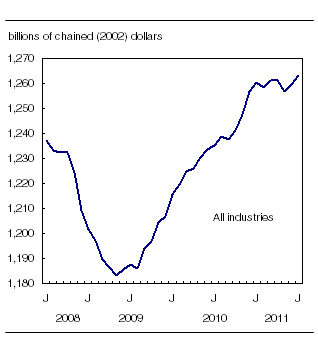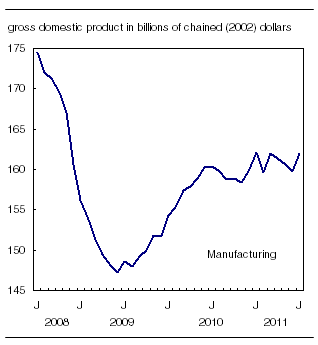Gross domestic product by industry
Archived Content
Information identified as archived is provided for reference, research or recordkeeping purposes. It is not subject to the Government of Canada Web Standards and has not been altered or updated since it was archived. Please "contact us" to request a format other than those available.
Related subjects
-
[an error occurred while processing this directive]
Real gross domestic product rose 0.3% in July following a 0.2% increase in June. Manufacturing and, to a lesser extent, wholesale trade and transportation services were the main sources of growth. Increases in utilities and the public sector (public administration, education and health services) were also recorded. Retail trade, mining and oil and gas extraction, construction and the finance and insurance sector decreased.
Real gross domestic product increases in July

Chart description: Real gross domestic product increases in July
Manufacturing increases
Manufacturing increased 1.4% in July following three consecutive monthly declines. Growth was broadly based, with manufacturing of both durable (+2.1%) and non-durable goods (+0.5%) advancing. Manufacturers of motor vehicles and parts, fabricated metals, machinery and chemical products posted significant gains. Manufacturing of food as well as furniture and related products was down.
Note to readers
The monthly gross domestic product (GDP) by industry data at basic prices are chained volume estimates with 2002 as the reference year. This means that the data for each industry and each aggregate are obtained from a chained volume index multiplied by the industry's value added in 2002. For the 1997 to 2008 period, the monthly data are benchmarked to annually chained Fisher volume indexes of GDP obtained from the constant-price input-output tables.
For the period starting with January 2009, the data are derived by chaining a fixed-weight Laspeyres volume index to the prior period. The fixed weights are 2008 industry prices.
This approach makes the monthly GDP by industry data more comparable with the expenditure-based GDP data, chained quarterly.
Revisions
With this release of monthly GDP by industry, the data incorporate the new 2008 input-output annual benchmarks, revised source data, improved methodologies and revised seasonal adjustment factors. As a result, the monthly series have been revised back to January 2007.
For more information about monthly GDP by industry, see the National economic accounts module on our website (www.statcan.gc.ca/nea-cen/index-eng.htm).
Manufacturing output rises after three monthly declines

Chart description: Manufacturing output rises after three monthly declines
Transportation and warehousing services resume growth
Transportation and warehousing services grew 1.8%, mainly as a result of a return to a more normal level of activity in postal services following labour disruptions in June. Rail, trucking and air transportation also showed growth in July.
Widespread gains in wholesale while retail declines
Wholesale trade rose 1.5% in July. Increases were registered in many of the sub-sectors, particularly in motor vehicles and parts, personal and household goods as well as machinery and equipment.
Retail trade fell 0.7%, with a significant decrease in motor vehicles and parts dealers. Excluding motor vehicle and parts dealers, retail trade was unchanged.
Utilities advance
The output of utilities increased 1.5%, as warmer than normal temperatures in most parts of the country led to higher demand for electricity. Natural gas distribution was up, partly as a result of increased industrial consumption.
Construction down
Construction declined 0.3% in July, with decreases in non-residential building construction and in engineering and repair work. Residential construction edged up 0.1% in July.
Activity in the home resale market softened in July, which led to a 1.1% decline in the output of real estate agents and brokers.
Mining and oil and gas extraction falls
Mining and oil and gas extraction fell 0.3%, as the significant decline in natural gas extraction outweighed the increase in crude petroleum production. Support activities for mining and oil and gas extraction also declined, as a result of reduced drilling activity.
Excluding oil and gas extraction, mining output grew 2.9%. This was largely attributable to gains in copper, nickel, lead and zinc mining following a period of production difficulties and maintenance work.
Finance and insurance down
The finance and insurance sector decreased 0.3%, as both the volume of trading on the stock exchanges and the sales of mutual funds declined. Lower activity for insurance carriers was also a factor in the decline.
Main industrial sectors' contribution to the percent change in gross domestic product, July 2011

Available on CANSIM: table 379-0027.
Definitions, data sources and methods: survey number 1301.
The July 2011 issue of Gross Domestic Product by Industry, Vol. 25, no. 7 (15-001-X, free), is now available from the Key resource module of our website under Publications.
Data on gross domestic product by industry for August will be released on October 31.
For more information, or to order data, contact the dissemination agent (toll-free 1-800-887-4623; 613-951-4623; iad-info-dci@statcan.gc.ca). To enquire about the concepts, methods or data quality of this release, contact Allan Tomas (613-951-9277), Industry Accounts Division.
- Date modified:
